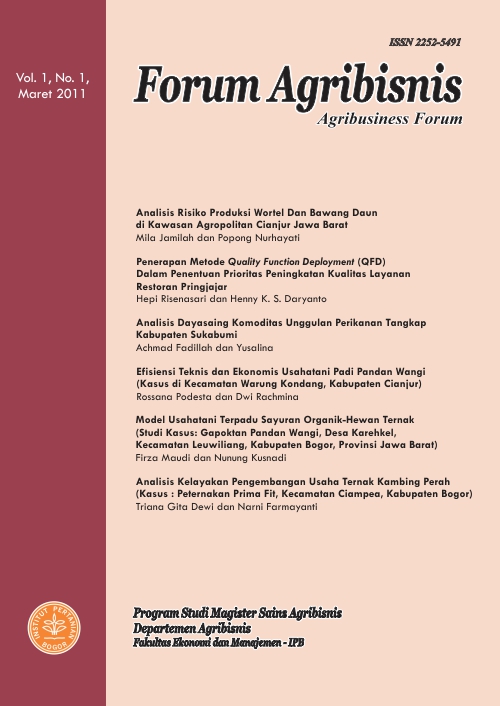MODEL USAHATANI TERPADU SAYURAN ORGANIK-HEWAN TERNAK (Studi Kasus: Gapoktan Pandan Wangi, Desa Karehkel, Kecamatan Leuwiliang, Kabupaten Bogor, Provinsi Jawa Barat)
Main Article Content
Abstract
Agriculture sector in developing country, including Indonesia, faces many problems such as scarcity in productive agriculture land and continuous increase of demand for food. Karehkel Village - West Java plans to develop integrated farming system (IFS) to address this issues. The farming system at Karehkel Village integrates organic vegetables, livestock, and produces organic fertilizer and manure. The purpose of this research is to develop quantitative model of IFS at Desa Karehkel and to determine the economic benefit IFS. Using the Linear Programming model the optimal solution shows that the farm profit of IFS is higher than the Non-IFS. The maximum profit can be reached by integrating organic vegetables – waste vegetables – livestock – manure – organic fertilizer (Bokashi). The optimal solution also indicated that the whole organic fertilizer product should be sold to the market since the cost per unit of organic fertilizer was relatively high. Imposing the organic fertilizer as the input of organic vegetables farming reduced IFS total profit.
Downloads
Article Details
How to Cite
MaudiF., & KusnadiN. (2011). MODEL USAHATANI TERPADU SAYURAN ORGANIK-HEWAN TERNAK (Studi Kasus: Gapoktan Pandan Wangi, Desa Karehkel, Kecamatan Leuwiliang, Kabupaten Bogor, Provinsi Jawa Barat). Forum Agribisnis : Agribusiness Forum , 1(1), 76-94. https://doi.org/10.29244/fagb.1.1.76-94
Section
Articles
The author submitting the manuscript must understand and agree that the copyright of the article manuscript must be submitted/transferred to the Journal Forum Agribisnis. This work is licensed under the Creative Commons Attribution-ShareAlike 4.0 (CC BY-SA) International License in which the Author and Reader can copy and redistribute the material in any media or format, and remix, modify and build material for any purpose, but they must provide appropriate credit (citing articles or content), provide a link to the license, and indicate whether there is a change. If you mix, change, or create material, you must distribute your contribution under the same license as the original.

